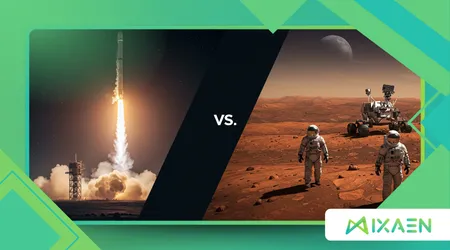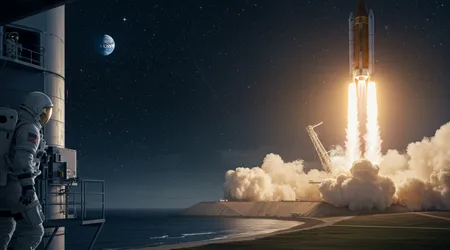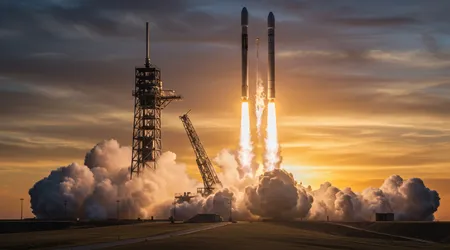SpaceX vs. NASA: A New Era or a Dangerous Privatization?

SpaceX vs. NASA these names spark a debate that’s as vast as the cosmos itself. In 2025, the race to explore space has shifted from Cold War rivalries to a complex dance between government agencies and private enterprises.
Anúncios
Once, space was the domain of nations, with NASA leading humanity’s charge to the stars.
Now, SpaceX, helmed by the audacious Elon Musk, has redefined what’s possible, launching rockets at a fraction of the cost and challenging the very structure of space exploration.
But is this partnership a bold leap into a new era or a risky gamble with humanity’s cosmic ambitions?
This question drives a conversation that’s not just about technology but about philosophy, economics, and the future of our species.
Let’s dive into the dynamics of SpaceX vs. NASA, exploring their roles, tensions, and what they mean for the universe beyond.
The stakes couldn’t be higher. NASA’s Artemis program aims to return humans to the Moon by 2027, while SpaceX’s Starship eyes Mars colonization.
Yet, recent tensions such as President Trump’s June 2025 threat to cut SpaceX’s contracts highlight a fragile balance. Is privatization fueling innovation or undermining public accountability?
This article unpacks the rivalry, synergy, and risks of SpaceX vs. NASA, offering a clear-eyed look at where we’re headed.
A Brief History of Space Exploration’s Titans
NASA, born in 1958, has long been the gold standard for space exploration. Its Apollo program landed humans on the Moon, a feat unmatched until today.
The agency’s meticulous approach, driven by public funding, prioritized science and safety. Fast-forward to 2002, when SpaceX emerged as a scrappy startup.
By 2025, it’s a juggernaut, launching 50-100 times more frequently than NASA’s Space Launch System (SLS). SpaceX vs. NASA isn’t just about launches; it’s a clash of cultures government rigor versus entrepreneurial daring.
SpaceX’s reusable Falcon 9 slashed costs, making space accessible. NASA’s SLS, costing $2 billion per launch, struggles to compete with Starship’s estimated $100 million.
++ Could Ancient Civilizations Have Dreamed of Space Travel?
This gap fuels debate: can a private company truly prioritize humanity’s goals? NASA’s legacy is scientific; SpaceX’s is commercial. Yet, their collaboration SpaceX’s Crew Dragon ferrying astronauts shows they’re intertwined.
The history isn’t black-and-white. NASA’s funding nurtured SpaceX’s early contracts, like the 2006 cargo deal. Without NASA, SpaceX might not exist.
Conversely, SpaceX’s efficiency pushes NASA to innovate. This symbiosis raises a question: are they rivals or reluctant partners shaping a new frontier?

The Case for Privatization: SpaceX’s Revolutionary Edge
Imagine a rocket that lands like a sci-fi dream, cutting costs dramatically. That’s SpaceX’s Falcon 9, a game-changer in SpaceX vs. NASA.
Reusability slashed launch costs to $60-90 million, compared to NASA’s $2 billion SLS. SpaceX’s 2025 launch rate over 100 annually dwarfs NASA’s. This efficiency drives commercial missions, like Starlink, and supports NASA’s goals.
Privatization sparks innovation. SpaceX’s Starship, designed for Mars, iterates rapidly despite setbacks, like the June 2025 explosion.
NASA’s methodical pace can’t match this agility. Private companies attract talent and investment, freeing NASA to focus on science, not logistics.
Also read: How Robotic Missions Prepare the Way for Human Exploration
A 2025 Reuters report notes SpaceX’s $15.5 billion revenue, surpassing NASA’s $1.1 billion commercial budget, showing private sector clout.
Yet, efficiency isn’t everything. SpaceX’s profit motive could sideline unprofitable science. Still, their ability to execute like the Axiom-4 mission in June 2025 proves private players can deliver.
The question isn’t whether SpaceX innovates but whether it can align with humanity’s broader goals.
SpaceX’s edge lies in its boldness. Where NASA deliberates, SpaceX experiments. The Starship program, despite failures, pushes boundaries NASA can’t afford to test.
This entrepreneurial spirit could accelerate lunar bases or Mars missions, but at what cost to oversight? The SpaceX vs. NASA dynamic thrives on this tension innovation versus accountability.
NASA’s Enduring Role: The Public Good Anchor
NASA remains the backbone of scientific exploration. Its James Webb Telescope, capturing exoplanet images in 2025, exemplifies its unmatched expertise.
Unlike SpaceX, NASA’s mission isn’t profit but discovery. The Artemis program, targeting a 2027 Moon landing, prioritizes long-term lunar science, not just headlines. In SpaceX vs. NASA, NASA’s public mandate ensures inclusivity.
The agency’s international partnerships like Europe’s ExoMars rover contrast with SpaceX’s insular approach.
NASA’s $25.4 billion 2025 budget, though strained, funds missions no private company would touch, like climate monitoring.
Read more: How Space Junk Threatens Future Missions and Satellites
A 2025 Congressional bill boosted Artemis funding, reinforcing NASA’s role despite Trump’s cuts. This stability anchors space exploration.
Yet, NASA’s bureaucracy can stifle progress. The SLS, criticized as outdated, lags behind SpaceX’s reusable rockets. Still, NASA’s rigorous testing ensures safety vital for human missions.
Without NASA’s oversight, could SpaceX’s risk-taking compromise astronaut lives? The SpaceX vs. NASA debate hinges on balancing speed with caution.
NASA’s role extends beyond launches. Its STEM programs, like the 2025 Earth-to-space YouTube call, inspire millions. SpaceX can’t replicate this public engagement.
While SpaceX pushes boundaries, NASA ensures space remains a shared human endeavor, not a corporate playground.
The Risks of Privatization: A Cosmic Monopoly?
Handing space to private companies sounds thrilling, but what if one dominates? In SpaceX vs. NASA, SpaceX’s near-monopoly on U.S. launches raises alarms.
A June 2025 Washington Post report noted NASA and Pentagon efforts to bolster competitors like Blue Origin after Trump’s threat to cut SpaceX contracts. Over-reliance risks instability.
SpaceX’s dominance stems from its contracts $5 billion with NASA alone. If Musk’s feud with Trump escalates, as seen in June 2025, critical missions could stall.
Imagine a tech billionaire holding the ISS hostage. This isn’t sci-fi; Musk briefly threatened to decommission Crew Dragon. Such power in one company is precarious.
Moreover, privatization prioritizes profit. SpaceX’s Starlink satellites, numbering over 6,000 in 2025, clutter orbits, risking collisions. NASA’s science-driven missions avoid such conflicts.
The SpaceX vs. NASA tension asks: can a corporation prioritize humanity over shareholders? The risk of a cosmic monopoly looms large.
Dependency also stifles competition. Blue Origin’s push for contracts, reported by CNBC in July 2025, shows rivals struggling to catch up.
Without alternatives, SpaceX could dictate terms, hiking costs or sidelining science. NASA’s public funding, though limited, ensures accountability private firms lack.
Collaboration or Competition? The Path Forward

The SpaceX vs. NASA narrative isn’t just rivalry it’s collaboration. SpaceX’s Crew-11 mission, set for August 2025, will carry NASA astronauts to the ISS.
This partnership leverages SpaceX’s efficiency and NASA’s expertise. Yet, competition drives progress. SpaceX’s cost-cutting forces NASA to rethink SLS, while NASA’s standards temper SpaceX’s risks.
A balanced future requires both. NASA’s 2025 Netflix deal brings space to millions, while SpaceX’s launches make it affordable. Together, they could achieve Mars missions by 2030.
But tensions like Congress’s 2025 SLS funding over Starship show misalignment. Why not fund both innovation and stability?
The path forward demands clear roles. NASA should lead science and oversight; SpaceX, logistics and innovation.
A 2025 Union Rayo report noted $325 million for SpaceX to deorbit the ISS by 2030, proving collaboration works. The SpaceX vs. NASA synergy could redefine humanity’s cosmic future if egos and politics don’t derail it.
Data supports this hybrid model. Below is a comparison of launch costs and frequencies in 2025, highlighting their complementary strengths:
| Entity | Launch Vehicle | Cost per Launch | 2025 Launches |
|---|---|---|---|
| NASA | SLS | $2 billion | 1-2 |
| SpaceX | Falcon 9 | $60-90 million | 100+ |
| SpaceX | Starship | ~$100 million | 5-10 (tests) |
This table underscores SpaceX’s volume and NASA’s precision. Together, they could dominate space exploration, but only with mutual respect.
The Human Element: Inspiration vs. Ambition
Beyond technology, SpaceX vs. NASA is about human dreams. NASA’s 2025 STEM initiatives, like the YouTube Earth-to-space call, ignite curiosity in kids.
SpaceX’s Starship tests, despite explosions, captivate dreamers with Mars visions. Both inspire, but differently NASA through science, SpaceX through ambition.
Consider a student watching a SpaceX launch on X, awestruck by a Falcon 9 landing. That’s raw inspiration. Now picture a teacher using NASA’s Curiosity rover data to explain Martian geology.
That’s intellectual fuel. Both are vital, but SpaceX vs. NASA pits spectacle against substance. Which shapes the next generation more?
NASA’s public mission ensures inclusivity, reaching underserved communities. SpaceX’s commercial focus, while inspiring, prioritizes profit-driven narratives.
A 2025 NPR report noted NASA’s role in making space data accessible to all, unlike SpaceX’s paywalled Starlink model. The human element demands both voices.
Conclusion: A Cosmic Crossroads
The SpaceX vs. NASA debate isn’t about winners or losers it’s about humanity’s future in space. NASA’s legacy of discovery and SpaceX’s relentless innovation are two sides of the same coin.
Together, they’ve made 2025 a pivotal year, with Artemis advancing and Starship testing Mars-bound tech.
Yet, risks like privatization’s monopolistic tendencies and political feuds, as seen in Trump’s 2025 threats, loom large. Can we balance ambition with accountability? The cosmos awaits our answer.
This partnership is like a spaceship with two engines: NASA’s steady thrust and SpaceX’s fiery boost. Alone, neither can reach Mars. Together, they might.
By fostering collaboration, investing in competitors, and prioritizing science, we can ensure space remains humanity’s frontier, not a corporate fiefdom.
The stars are closer than ever let’s not lose sight of why we’re reaching.
Frequently Asked Questions
1. Why is the SpaceX vs. NASA debate important in 2025?
It shapes how we explore space. NASA ensures scientific rigor; SpaceX drives cost-efficiency. Their balance affects missions like Artemis and Mars colonization.
2. Could SpaceX replace NASA entirely?
No. SpaceX excels in launches, but NASA’s scientific expertise and public mandate are irreplaceable. Their 2025 collaborations, like Crew-11, prove they’re complementary.
3. What are the risks of privatizing space exploration?
Privatization risks monopolies, profit-driven decisions, and reduced accountability. SpaceX’s 2025 dominance highlights the need for competitors like Blue Origin.
4. How do NASA and SpaceX inspire people differently?
NASA inspires through education and discovery, like 2025’s STEM programs. SpaceX captivates with bold feats, like Starship tests, fueling dreams of Mars.
Citations:
